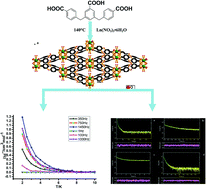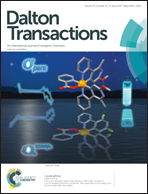A series of rare earth complexes with novel non-interpenetrating 3D networks: synthesis, structures, magnetic and optical properties†
Abstract
A series of metal–organic framework {Ln(BCPBA)(H2O)}n {Ln = Nd (1), Sm (2), Eu (3), Tb (4), Dy (5)}; {[Ln(BCPBA)(H2O)](H2O)}n {Ln = Pr (6), Gd (7)} have been synthesized through the hydrothermal synthesis method. These compounds possess non-interpenetrating 3D networks with 10.1438 Å × 17.9149 Å rhombic channels along the [001] direction. The results of temperature-dependent magnetic susceptibility measurements indicate that compounds 4 and 7 exhibit LnIII⋯LnIII antiferromagnetic interactions, while compound 5 exhibits LnIII⋯LnIII ferromagnetic interactions. Frequency dependent out-of-phase signals were observed in alternating current (ac) magnetic susceptibility measurements which indicate that they have slow magnetic relaxation characteristics. The luminescent properties of 1, 2, 3, 4, and 5 are also discussed. Due to the good match between the lowest triplet state of the ligand and the resonant energy level of the lanthanide ion, compound 4 has longer fluorescence lifetime (τ1 = 400.0000 ms, τ2 = 1143.469 ms) and higher quantum yield (Φ = 42%) compared with other compounds.


 Please wait while we load your content...
Please wait while we load your content...